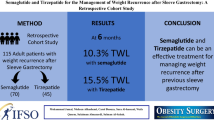Abstract
Background
While Roux-en-Y gastric bypass (RYGB) is effective in achieving weight loss and improving obesity-related co-morbidities, insufficient weight loss in the long-term can occur. The goal was to assess whether banded vs. non-banded RYGB reduces the risk of insufficient weight loss at 5-year follow-up.
Methods
This is a retrospective single-center cohort study from Switzerland. We assessed the 5-year metabolic trajectories in terms of body weight, body mass index, glucose control, lipid profile and blood pressure of two surgical cohorts undergoing identical RYGB procedures with or without banding using a uniform 6.5 cm silastic Fobi band. Insufficient weight loss was defined as < 50% excess weight loss (EWL) at 5 years.
Results
A total of 55 patients receiving banded (Fobi) and 55 patients receiving non-banded (non-Fobi) RYGB were included in the analysis. 5-year follow-up was 91% for both groups. Percentage of EWL at 5 years was 78.11 ± 26.1% and 73.5 ± 27%.3 for the Fobi vs. non-Fobi group (p = 0.368), respectively. Insufficient weight loss (defined as < 50%EWL) at 5 years or last follow-up was significantly higher in the non-Fobi group compared to the Fobi group (19/55 vs. 9/55, respectively, OR = 2.639 (95% CI 1.066, 6.531), p = 0.036). Surrogate markers for cardiometabolic outcomes consistently improved over time, without differences between the groups. During the follow-up period, Fobi-removal was necessary in nine patients (16.3%).
Conclusion
Banded-RYGB lowered the odds of insufficient weight loss at 5 years follow-up by approximately 62%. Further research is needed to explore the effect of restriction on eating behaviour and neuroendocrine responses after RYGB.


Similar content being viewed by others
References
Schauer PR, Bhatt DL, Kirwan JP et al (2017) Bariatric surgery versus intensive medical therapy for diabetes - 5-Year Outcomes. N Engl J Med 376(7):641–651. https://doi.org/10.1056/NEJMoa1600869
Sjöström L, Peltonen M, Jacobson P et al (2012) Bariatric surgery and long-term cardiovascular events. JAMA 307(1):56–65. https://doi.org/10.1001/jama.2011.1914
King WC, Hinerman AS, Belle SH, Wahed AS, Courcoulas AP (2018) Comparison of the performance of common measures of weight regain after bariatric surgery for association with clinical outcomes. JAMA 320(15):1560–1569. https://doi.org/10.1001/jama.2018.14433
Monaco-Ferreira DV, Leandro-Merhi VA (2017) Weight regain 10 Years after Roux-en-Y gastric bypass. Obes Surg 27(5):1137–1144. https://doi.org/10.1007/s11695-016-2426-3
Sumithran P, Proietto J (2013) The defence of body weight: a physiological basis for weight regain after weight loss. Clin Sci 124(4):231–241. https://doi.org/10.1042/CS20120223
da Silva FB, Gomes DL, de Carvalho KM (2016) Poor diet quality and postoperative time are independent risk factors for weight regain after Roux-en-Y gastric bypass. Nutrition 32(11–12):1250–1253. https://doi.org/10.1016/j.nut.2016.01.018
Cardeal MA, Faria SL, Faria OP, Facundes M, Ito MK (2016) Diet-induced thermogenesis in postoperatve Roux-en-Y gastric bypass patients with weight regain. Surg Obes Relat Dis 12(5):1098–1107. https://doi.org/10.1016/j.soard.2016.01.019
Jirapinyo P, Dayyeh BK, Thompson CC (2016) Gastrojejunal anastomotic reduction for weight regain in roux-en-y gastric bypass patients: physiological, behavioral, and anatomical effects of endoscopic suturing and sclerotherapy. Surg Obes Relat Dis 12(10):1810–1816. https://doi.org/10.1016/j.soard.2016.09.036
Fobi MA, Lee H (1994) SILASTIC ring vertical banded gastric bypass for the treatment of obesity: two years of follow-up in 84 patients [corrected]. J Natl Med Assoc 86(2):125–128
Fried M, Yumuk V, Oppert JM et al (2014) Interdisciplinary European guidelines on metabolic and bariatric surgery. Obes Surg 24(1):42–55. https://doi.org/10.1007/s11695-013-1079-8
Brethauer SA, Kim J, el Chaar M et al (2015) Standardized outcomes reporting in metabolic and bariatric surgery. Surg Obes Relat Dis 11(3):489–506. https://doi.org/10.1016/j.soard.2015.02.003
Zarate X, Arceo-Olaiz R, Montalvo Hernandez J, García-García E, Pablo Pantoja J, Herrera MF (2013) Long-term results of a randomized trial comparing banded versus standard laparoscopic Roux-en-Y gastric bypass. Surg Obes Relat Dis 9(3):395–397. https://doi.org/10.1016/j.soard.2012.09.009
Lemmens L (2017) Banded gastric bypass: better long-term results? a cohort study with minimum 5-year follow-up. Obes Surg 27(4):864–872. https://doi.org/10.1007/s11695-016-2397-4
Coulman KD, MacKichan F, Blazeby JM, Owen-Smith A (2017) Patient experiences of outcomes of bariatric surgery: a systematic review and qualitative synthesis. Obes Rev 18(5):547–559. https://doi.org/10.1111/obr.12518
Deden LN, Cooiman MI, Aarts EO et al (2017) Gastric pouch emptying of solid food in patients with successful and unsuccessful weight loss after Roux-en-Y gastric bypass surgery. Surg Obes Relat Dis 13(11):1840–1846. https://doi.org/10.1016/j.soard.2017.07.031
Miholic J, Hoffmann M, Holst JJ et al (2007) Gastric emptying of glucose solution and associated plasma concentrations of GLP-1, GIP, and PYY before and after fundoplication. Surg Endosc 21(2):309–314. https://doi.org/10.1007/s00464-005-0804-3
Price HI, Gregory DM, Twells LK (2013) Weight loss expectations of laparoscopic sleeve gastrectomy candidates compared to clinically expected weight loss outcomes 1-year post-surgery. Obes Surg 23(12):1987–1993. https://doi.org/10.1007/s11695-013-1007-y
Z’graggen K, Guweidhi A, Steffen R et al (2008) Severe recurrent hypoglycemia after gastric bypass surgery. Obes Surg 18(8):981–988. https://doi.org/10.1007/s11695-008-9480-4
Author information
Authors and Affiliations
Corresponding author
Ethics declarations
Disclosures
Drs Catherine Tsai, Maria Dimou, Markus Naef, Rudolf Steffen, Jörg Zehetner, Christos T Nakas, and Lia Bally have no conflict of interest or financial ties to disclose.
Additional information
Publisher's Note
Springer Nature remains neutral with regard to jurisdictional claims in published maps and institutional affiliations.
Rights and permissions
About this article
Cite this article
Tsai, C., Dimou, M., Naef, M. et al. Insufficient weight loss after banded vs. non-banded primary gastric bypass surgery: insights from an observational 5 year follow-up study. Surg Endosc 36, 5964–5969 (2022). https://doi.org/10.1007/s00464-021-08952-7
Received:
Accepted:
Published:
Issue Date:
DOI: https://doi.org/10.1007/s00464-021-08952-7




